If you're scrolling through X and spot a tweet from BSCNews hyping up VeChain's Hayabusa upgrade, you might wonder what's the big deal. Well, as someone who's been deep in the crypto trenches, let me break it down for you in plain English. VeChain, known for its enterprise-grade blockchain solutions like tracking supply chains and sustainability efforts, is leveling up its game with this upgrade. It's not just tech jargon—it's a move that could ripple through the broader crypto space, including how meme tokens operate on efficient networks.
What Exactly Is the Hayabusa Upgrade?
Named after the Japanese word for peregrine falcon—think speed and precision—the Hayabusa upgrade is phase two of VeChain's Renaissance roadmap. At its core, it's switching the VeChainThor blockchain from a Proof-of-Authority (PoA) system to a Delegated Proof-of-Stake (DPoS) model. PoA is like having a trusted club of validators running the show for stability, but it can feel a bit centralized. DPoS opens the doors wider: anyone with enough tokens can join in, making the network more decentralized and community-driven.
In simple terms, PoA relies on pre-selected nodes to verify transactions, which is great for consistency but limits participation. DPoS lets token holders stake their coins to vote for validators or become one themselves, spreading out the power and potentially making the chain more secure against attacks.
Key Features You Need to Know
This upgrade packs a punch with several enhancements:
Consensus Overhaul: To become a validator, you'll need at least 25 million VET (VeChain's main governance token). Don't have that much? No sweat—you can delegate your smaller stake to a validator and share in the rewards. This is based on how much you stake and how well the validator performs. Transaction fees, paid in VTHO (the gas token for powering operations), feed into a reward pool that fluctuates with network activity.
Staking Made Smarter: Programs like StarGate offer flexible options, starting as low as 10,000 VET for a Dawn Node. There's even a bonus pool of over 5 billion VTHO to be distributed in the first six months. Tools like the VeWorld wallet make it easy to manage, and partnerships with big names like BitGo (for secure storage with insurance), Crypto.com (for easy trading), and Keyrock (as a validator) add credibility.
Tech Boosts for Devs: It's fully compatible with the Ethereum Virtual Machine (EVM), meaning devs can build apps that play nice with other blockchains. Plus, improved JSON-RPC interfaces make cross-chain development smoother. If you're tinkering with meme tokens or DeFi projects, this could mean easier integration and faster transactions.
Ecosystem Perks: With over 4 million users, VeChain's apps like VeBetterDAO encourage community involvement. It's all about sustainable growth, tying into real-world uses like partnering with Walmart for supply chain tracking or UFC for fan engagement.
How It Shakes Up Tokenomics
Tokenomics—the economics of tokens—is where Hayabusa really shines (or shakes things up). Previously, holding VET automatically generated VTHO passively, which led to inflation as more VTHO flooded the market. Now, that's gone. Rewards come only from active staking, creating a deflationary vibe. Unclaimed VTHO or fees from transactions get burned or redistributed, tying the token's value more tightly to actual network demand.
For VET holders, this means staking is key to earning VTHO, which could drive up demand and prices. As of early September 2025, VET was hovering around $0.023, with whispers of a breakout above $0.03 if the upgrade hype builds. VTHO becomes scarcer and more valuable as the network buzzes with activity, which is music to the ears of anyone building or trading on VeChain.
Timeline and What's Next
The ball started rolling in mid-August 2025 with a proposal on VeVote, VeChain's governance platform. Voting wrapped up quickly with full approval by August 25. The testnet kicked off in early September for ironing out kinks, and the mainnet launch is slated for late December 2025—right in Q4. If all goes smooth, expect a more robust VeChain by year's end.
Why This Matters for Meme Token Fans
Sure, VeChain isn't a meme token itself—it's more about serious stuff like real-world assets and sustainability. But for blockchain practitioners diving into memes, this upgrade highlights trends in decentralization and efficient token models that could inspire your next project. Faster, cheaper transactions? Lower inflation? Broader community involvement? These are tools that meme creators can learn from to make their tokens more appealing and sustainable. Keep an eye on how this plays out; it might just influence the next wave of crypto innovation.
For the full scoop, check out the original article on BSC News. If you're staking or building on VeChain, now's the time to get involved—head over to VeVote or grab the VeWorld wallet to join the action.

